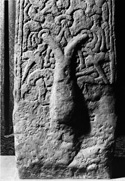Select a site alphabetically from the choices shown in the box below. Alternatively, browse sculptural examples using the Forward/Back buttons.
Chapters for this volume, along with copies of original in-text images, are available here.
Object type: Cross-shaft and -head
Measurements: H. 165 cm (65 in); W. (head) 71 cm (27.75 in) (shaft) 47 > 37 cm (18.5 > 14.5 in); D. 14 cm (5.5 in)
Stone type: Medium-grained red sandstone (St Bees sandstone)
Plate numbers in printed volume: 250, 252 - 5
Corpus volume reference: Vol 2 p. 94-95
(There may be more views or larger images available for this item. Click on the thumbnail image to view.)
Cross-head, type A9, with circle, type 3; slab-like shaft with marked entasis. There is an undecorated area on all faces at the bottom of the shaft for insertion into the ground or socket.
A (broad): At the centre of the head is a flat rosette boss; in the horizontal arms, within the circle, there is a figure-of-eight knot formed of median-incised strands. The equivalent vertical arms have a tighter triquetra knot using similar strands. All of this arm ornament, like that on the circle and on the protruding upper arm, is framed by a thin roll moulding. The circle carries three-strand plain plait and the protruding upper arm a figure-of-eight knot, the latter worked in strands with median-incised lines. The shaft below has a single panel framed laterally by a double roll moulding, but with no lower border. The upper part of the panel is occupied by a multiple ring-chain which merges below into a bulb-like object, carved in high relief. The two branches rising from this bulb terminate in plain split leaves. Flanking the bulb are two bird-like forms and fragments of plaitwork and pellets.
B (narrow): The side of the upper arm contains a figure-of-eight knot and the edge of the circle is decorated with a three-strand plain plait bordered by a thin double roll moulding which continues down the side of the shaft. The end of the horizontal arm carries a figure-of-eight knot.
C (broad): The decoration on the head is similar to that on face A except that the rosette boss is more domed and the interlace in the right arm seems to be a three-strand plain plait or triquetra; the triquetra in the upper arm is bungled. There are two panels on the shaft, both bordered laterally by a double roll moulding, which are separated from each other by an incised groove. The inner lateral moulding turns to form the bottom border of the lower panel. The top of the upper panel carries an eight-strand plain plait which links, below a crude arch, to irregular interlace set in open ground and using free rings. In the narrow panel below is key pattern, divided into four squares.
D (narrow): The decoration is identical to that on face B except that the ornament on the end of the horizontal arm is a bungled triquetra.
This is the most complete of the Cumbrian circle-headed crosses (see pp. 31–2). Characteristic of the group is the plait decoration of the circle and the division of face C into two panels, the lower one reduced to a narrow strip (see Muncaster 1 and Aspatria 1). The multiple form of ring-chain is a local Cumbrian development of a Borre-derived motif shared with Gosforth 1 and 3 and Cross Canonby 5.
The bulb-like object has been the subject of much interpretative speculation. To Calverley the nineteenth-century setting of the stone, with the bulb half-buried beneath the ground, suggested the appearance of Yggdrasill, the world-tree of Scandinavian mythology (de Vries 1956–7, 380–3). Though the fullest Descriptions of this concept are much later than the tenth-century date of the carving (Vǫluspá; Snorri Sturluson) the combined information of such various sources as Hávamál, Adam of Bremen, and Indo-European comparative material, suggest that familiarity with the idea could have existed in the Viking colonies at this date. Against this interpretation is the fact that the literary sources stress the three-fold nature of the tree's roots and there is no trace of this division at Dearham; these written sources may, however, be recording variant, and often late, traditions. More important, perhaps, is that Calverley's interpretation ignored the Christian concept of the cross as cosmic tree (Greenhill 1954; Kaske 1967; Utley 1957). If the Dearham cross did give the appearance of a living object growing from its bulb-like root then it was potentially susceptible to Christian as well as pagan interpretations.



